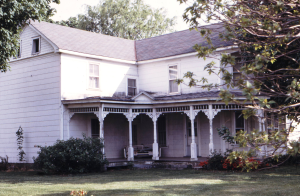
Death of Baker at the Battle of Ball’s Bluff. Library of Congress.

Full-length portrait of Baker in uniform from the Library of Congress.
I hope you will excuse this longish post, but once started, I realized it needed to be a bit more than originally written. After my post on Col. Baker when I was in San Francisco, I began to wonder if there was a photographic record of his original gravestone. The current stone in the Military Cemetery at the Presidio was placed there in 1940, but he wasn’t originally buried there. I was also intrigued with all the places where he has been memorialized. As often happens during a war, heroes emerge whose story is significant at the time, but eventually becomes an historical footnote. Their memory lives on mostly because of all the places that were named after them while their story was still fresh. (Montgomery County is one of many counties named after Richard Montgomery, a Revolutionary War hero, who is remembered mostly for all the places that were named for him after his death in 1775.) BUT then I realized that today, October 21, is the 151st anniversary of the Battle of Ball’s Bluff, and so I had to say more.
Dorothy had the thankless task of writing the stories for Annington, the Battle of Ball’s Bluff, and the C & O Canal. These stories trip all over each other, and separating them into three distinct tales was a challenge. You see, while Baker died at Ball’s Bluff, he haunts Annington. The ghosts that were created out of the tragedy that was the Battle of Ball’s Bluff spilled over into the C & O Canal.

Ball’s Bluff Battlefield – stone marks where Baker died.
The Battle of Ball’s Bluff was a debacle. Ball’s Bluff is a steep cliff rising above the Potomac River in Loudon County, VA. The Confederates had the high ground. Baker should have called for a retreat, and was advised to do so by his subordinates. Perhaps it was being back on the battlefield after so many years, or hoping to take a decisive stand early in the war, but Baker pushed forward. It was a rout, with the Union wounded and dead clogging the Potomac. Baker, too, died, and was temporarily laid to rest at Congressional Cemetery in Washington, D.C.. Then, after some negotiations, it was decided that California would get him even though he was a senator from Oregon. (He had been a lawyer in San Francisco before moving to Oregon.) After a lengthy train ride to San Francisco, with many stops for mourners to view him along the way, he reached Lone Mountain Cemetery (later renamed Laurel Hill Cemetery) in San Francisco. This was an appropriate place as Baker had given the dedication speech for the cemetery when it opened in 1854.

Baker Monument, Laurel Hill Cemetery. San Francisco History Center, San Francisco Public Library.
In 1940, after it was decided to close Lone Mountain/Laurel Hill, Baker was moved to the Presidio, where his grave can be found at plot site OSD 488.
Meanwhile, how is Baker remembered? There are three forts named for him – a Fort Baker can be found in Washington, D.C., Nevada, and San Francisco. In addition, San Francisco has Baker Beach and Baker Street. Also in California, Gray Eagle Creek was named for Baker – the “gray eagle of republicanism.” In Oregon, where Baker was senator, there is Baker County, Baker City, and Edward D. Baker Day (February 24). His likeness can be found in the U.S. Capitol and the Illinois State House, where he had practiced law.
With so many possible places to haunt, is it any wonder that Baker seems to have chosen Annington, the site of his last peaceful meal?
(A special thank you to Lorna Kirwan at the Bancroft Library at UC Berkeley who actually located the image for me.)











